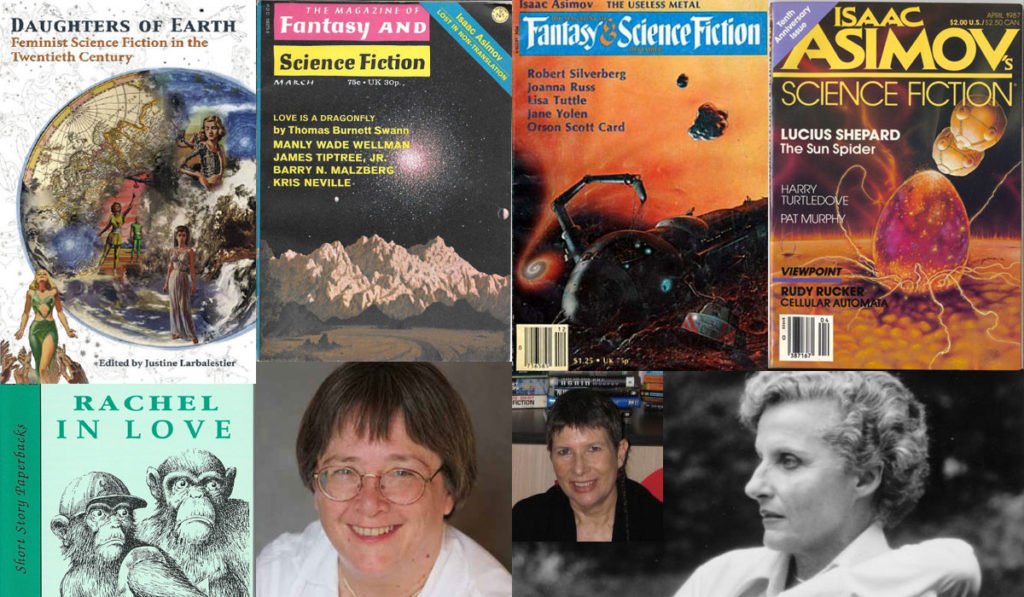
This Month On Changing the Map
This month we return to Justine Larbalestier’s excellent collection of feminist science fiction stories and essays, Daughters of Earth: Feminist Science Fiction in the Twentieth Century. Three stories in her anthology perfectly illustrate one of the most compelling themes in fantastic feminist fiction of the 1970’s and 1980’s: sex, and how it affected women then, and now.
Spoilers: I’ve discussed every story in full, including the endings.
“And I Awoke And Found Me Here On the Cold Hill’s Side”
by James Tiptree Jr.
First published in The Magazine of Fantasy and Science Fiction, March 1972
Essay by Wendy Pearson
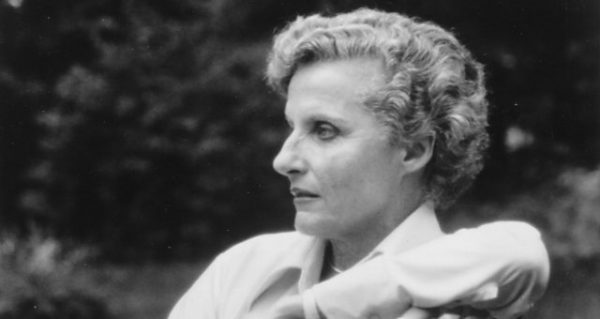 About the Author: James Tiptree Jr. was born Alice Hastings Bradley in 1915 and died in 1987 in Mclean, Virginia. The daughter of a naturalist and a writer, she traveled extensively as a child. After training as a graphic artist, she joined the Air Force during World War II and worked for the photo-intelligence group, and after the war, she worked for the CIA.
About the Author: James Tiptree Jr. was born Alice Hastings Bradley in 1915 and died in 1987 in Mclean, Virginia. The daughter of a naturalist and a writer, she traveled extensively as a child. After training as a graphic artist, she joined the Air Force during World War II and worked for the photo-intelligence group, and after the war, she worked for the CIA.
She began writing science fiction in the late 1960’s under the pseudonym James Tiptree Jr., a name she came up with from a jar of marmalade. After her outing as a woman in the 1970’s, Tiptree said this about her choice to use a male pseudonym:
“A male name seemed like good camouflage. I had the feeling that a man would slip by less observed. I’ve had too many experiences in my life of being the first woman in some damned occupation.”
About the Story: The story’s title is taken from a line in Keat’s famous poem about a knight’s seduction and destruction by a strange and beautiful lady — La Belle Dame sans Merci.
It opens with a conversation between an engineer waiting for his wife to arrive at a space station and a reporter from Earth who’s been sent to document life in space for viewers back home. They meet near an arrival port, the reporter asking the weary-looking engineer for stories about his encounters with aliens. What he gets is a cautionary tale about the consequences of obsession.
The engineer describes the first time he met an alien, back in a bar in D.C. that was frequented by extraterrestrial ambassadors.
“Little Junction was the place where the lower orders went, the clerks and the drivers out for kicks. Including, my friend, the perverts. The ones who can take humans. Into their beds, that is.” (pg 162)
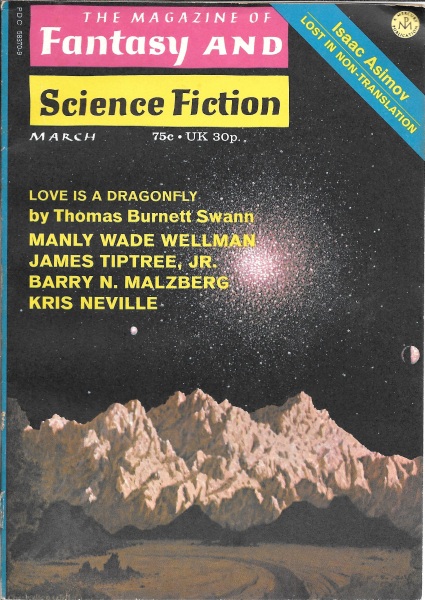 The engineer, who had been aching to see an alien in the flesh, meets a human women in the bar. She’s bruised and marked up by her sexual encounters with extraterrestrials. Then music starts, and an alien called a Sellice begins to dance.
The engineer, who had been aching to see an alien in the flesh, meets a human women in the bar. She’s bruised and marked up by her sexual encounters with extraterrestrials. Then music starts, and an alien called a Sellice begins to dance.
Her arms went up and those blazing lemon-colored curves pulsed, waved, everted, contracted, throbbed, evolved unbelievably welcoming, inciting permutations. Come do it to me, do it, do it here and here and here and now. You couldn’t see the rest of her, only a wicked flash of mouth. Every human male in the room was aching to ram himself into that incredible body. I mean it was pain. (pg 164)
The young man was so enraptured, so drunk with his desire for more sexually-charged alien encounters that he gets a degree in engineering so he can work on a space station and be near them.
And that’s where he comes to terms with the truth — that fascination with the new and different has been pushing men into colonialization for centuries, and nothing good comes of it for the colonized. Only in this case, it’s the humans who are being colonized. They’ve become so enraptured with aliens that they’re willing to take bad trade deals just be involved with them in some way, which could threaten the future of the human race.
The engineer’s wife arrives. We realize it’s the woman he met in the bar back in D.C., their marriage more of a shared fate — their fascination with aliens — than a loving human relationship.
He warns the reporter to go home, forget his obsession with aliens, and try to save the human race while there’s still time.
“Tell them,” he said, turning to go. “Go home and tell them.” (pg 167)
Sadly, it’s clear at the end of the story that the reporter will succumb to the same fascination.
How It Changed the Map: Before her outing as a woman in the late 1970’s, Robert Silverberg said this of her writing:
“It has been suggested that Tiptree is female, a theory I find absurd, for there is to me something ineluctably masculine about Tiptree’s writing.”
Is her writing masculine? Is there such a thing as masculine and feminine writing? That’s a discussion for another column, but what’s not in question was Tiptree’s ability to slide into the male psyche and write convincingly from a male point of view.
“The Cold Hill’s Side” displays her deep understanding of male sexuality, and its attraction to the strange. It’s not hard to imagine that when Tiptree traveled to foreign countries as a child and again as an adult working for the CIA, she witnessed men chasing the different, and craving that next high. Near the end of the story, the engineer explains this truism to the reporter.
“Anything different-colored, different nose, ass, anything, man has to fuck it or die trying. That’s a drive, y’know, it’s built in.” (pg 166)
Her understanding of this facet of male — biology? physiology? — and its destructive power in both domestic relationships (casual hookups and long-term affairs) and international relations (trade inequities and racial oppression) causes plenty of heartbreak in our world. What havoc might that obsession cause in the future? Could it be the end of us?
It’s this steely-eyed look at the one aspect of male sexuality — the desire to sexually conquer the new and different — that makes this story a gritty and gripping piece of feminist science fiction.
“Wives”
by Lisa Tuttle
First published in The Magazine of Fantasy and Science Fiction, December 1979
Essay by Cathy Hawkins
 About the Author: Lisa Tuttle was born in 1952 in Houston, Texas. The author of over a dozen novels, she wrote The Encyclopedia of Feminism in 1986, as well as books on writing and gender issues. She currently resides in rural Scotland.
About the Author: Lisa Tuttle was born in 1952 in Houston, Texas. The author of over a dozen novels, she wrote The Encyclopedia of Feminism in 1986, as well as books on writing and gender issues. She currently resides in rural Scotland.
About the Story: The story opens as a wife named Susie wakes up, realizing all the men in town have gone away. She’s pleased but distracted because she is drawn to a smell — the scent of another wife in heat. As she leaves her home to find the other wife, she notices her husband’s pet spider eating the sofa — and we know that these wives and their men aren’t in Kansas.
The “wives” in this story are aliens on an alien planet, oppressed and colonized by human males from Earth. After a war in which much of the population was wiped out, the remaining creatures molded themselves into what their male human conquerors wanted — cooks and housekeepers, sweethearts and lovers, temporary replacements for the real women they left back on Earth. The wives wear “skintights” to mold their insect-like bodies into something approximating a female form, squishing their three breasts to look like the human two, filling their legs with silicone to mask their stick-thin appendages, and covering it all up with dresses and make-up and perfume, just like the men want them to.
But the perfume can’t hide everything, particularly the smell they emit when they are in heat. Susie can sense that her friend Doris is in heat, and with the men temporarily gone to fight battles somewhere else on the planet, they can mate as they would have before the invasion.
But when Doris, too, was naked, Susie suddenly felt shy and a little frightened. It would be wrong to mate here in the settlement built by man, wrong and dangerous. They must go somewhere else, somewhere they could be something other than wives for a little while, and follow their own natures without reproach. (pg 192)
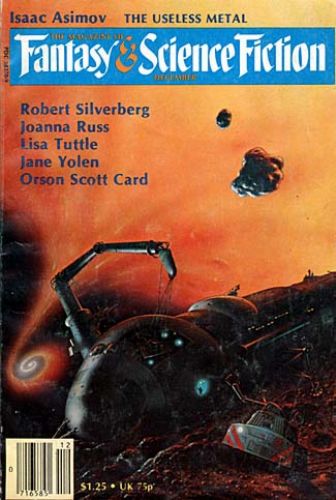 In a “place of stone” outside of the human settlement, the two creatures mate. Neither can remember their names before the men gave them human names, but they can remember how to have sex, and as they rest after the act, the ponder what to do with the egg they’ve created. Susie wants to raise it. Doris protests.
In a “place of stone” outside of the human settlement, the two creatures mate. Neither can remember their names before the men gave them human names, but they can remember how to have sex, and as they rest after the act, the ponder what to do with the egg they’ve created. Susie wants to raise it. Doris protests.
“Are you crazy? Who would carry it then? One of us would have to go without a skintight, and do you think either of our husbands would let us slop around for four months without a skintight? And then when it’s born how could we hide it? Men don’t have babies, and they don’t want anyone else to. Men kill babies, just as they kill all their enemies.” (pg 193)
The frightened Doris returns to her human-built home, but Susie remains with the egg for a while. The act of sex and the creation of an egg have woken a strength and rebelliousness that she’d forgotten she possessed.
She wanted to be what she had been born to be, but she could not remember what that was. She only knew that she could be Susie no longer. She would be no man’s wife. (pg 194)
She returns to the settlement to entreat the other wives to action. She encourages them to try to remember their old life — already Susie is beginning to remember things — and perhaps together they could rise up. They could hide, or they could fight. They don’t have to let themselves die slowly, serving the needs of their conquerors.
But the other wives are too frightened, too afraid to rise up. They’d rather live, even if it means a slow death of the soul. Unable to change their minds, Susie returns to her house defeated. She knows the other wives will come to kill her. They have to. Rebellion by one could mean death for them all. Susie accepts her fate. She’d rather be dead than live a lie.
How It Changed the Map: Tuttle’s story speaks to a key issue for women in the late 1970’s — how for some women, marriage could become a prison instead of a partnership. With fewer opportunities for women in the workforce at that time, women often married for security, and men expected certain things in return for their battles in the workplace: a clean house, a hot meal, and an attractive, willing sex partner. The last line of Tuttle’s story perfectly sums up many male attitudes in the 1970’s, men who had grown up in the 1930’s, 1940’s, and 1950’s.
“Three tits and the best coffee in the universe,” he said with satisfaction, squeezing one of the bound lumps of flesh on her chest. “With this to come home to, it kind of makes the whole war-thing worthwhile.” (pg 198)
For many 1970’s women, particularly as they watched their more emancipated daughters enter the workplace, they felt left behind, trapped in a contract that no longer worked for them. They wanted to be free to figure out who they really were outside of being domestic chattel. Susie longs to remember who she really was before she became a wife, before she molded herself (in this case, literally) into something that pleased her husband.
Susie’s call to leave and live apart from the men raises another issue women grappled with in the 1970’s. If women left their marriages to find their true selves, could they survive? Could they support themselves? Would they find another community that accepted and protected them? Ultimately, Tuttle’s haunting story leaves this question in our minds: what’s worse — to risk poverty and stigmatization as a free woman, or die the slow death of an oppressed one? Many of our mothers and grandmothers faced the same question. That’s what makes this story so resonant.
“Rachel In Love”
by Pat Murphy
First published in Asimov’s Science Fiction Magazine, April 1987
Essay by Joan Haran
 About the Author: Pat Murphy is an American author born in Washington State in 1955. In addition to writing award-winning fiction, she is a life-long scientist and science educator. Murphy is a co-founder of the James Tiptree Jr. Literary Award for encouraging the exploration and expansion of gender.
About the Author: Pat Murphy is an American author born in Washington State in 1955. In addition to writing award-winning fiction, she is a life-long scientist and science educator. Murphy is a co-founder of the James Tiptree Jr. Literary Award for encouraging the exploration and expansion of gender.
About the Story: “Rachel in Love” opens with a small, brown chimpanzee named Rachel watching a Tarzan movie on television. Hungry and ready for breakfast, she goes to her father’s bedroom and finds him dead. (Her father — Dr. Aaron Jacob — is a human.) Rachel is inconsolable.
Although we’re inclined to assume that this is a highly intelligent chimp thinks of the researcher as her father, we discover that Aaron actually IS her father. At least the father of the consciousness living inside the chimp. Rachel was once Aaron’s young teenage daughter who was killed in an auto accident. Distraught at her death, he transferred his daughter’s personality and memories into the body of a young chimp.
Both the chimp’s memories — of a mother, of the jungle — and Rachel’s memories, of her own mother, of her long blond hair, coexist together. When Rachel-the-chimp looks into a mirror, she expects to see Rachel-the-girl, and can’t quite figure out why she doesn’t.
Sometimes, when Rachel looks at her gnarled brown fingers, they seem alien, wrong, out of place. She remembers having small, pale, delicate hands. Memories lie upon memories, layers upon layers, like the sedimentary rocks of the desert buttes. (pg 219)
Eventually Dr. Jacobs is missed and the police arrive at the ranch house. Rachel is sedated and caged in a lab where they breed chimps for medical experiments. Her future looks very different from life with her father.
In indifferent tones, the men talk of horrible things. The adolescent chimps at the end of the corridor are being fed a diet high in cholesterol to determine cholesterol’s effects on the circulatory system. A group of pregnant females are being injected with male hormones to determine how that will affect the female offspring. (pg 233)
Although she could communicate with them using sign language, Rachel hesitates. Her father always warned her that other people might not understand her and the things he’d done. Only when she glimpses an older chimp signing to a janitor does Rachel choose to trust someone.
Jake the janitor is deaf, and an alcoholic, but he’s kind to the animals when he knows the researchers aren’t looking. Rachel signs her distress.
“I’m not a monkey. I’m a girl. I don’t belong here. Please let me out.” (pg 228)
Jake doesn’t believe her, but he agrees to let her out after Rachel promises to help him do his work. Each night she helps him clean the lab, getting potato chips and Jake’s favorite treat, whisky, in return. After their work is done, she sits with Jake while he reads magazines and drinks. She prefers his human companionship and occasional touch to the cold steel of the cage. Eventually she becomes infatuated with Jake. She tries to make him like her, painting her chimp eyes with makeup like the human girls in his magazines.
Jake squats beside her and stares at her eyes. Rachel puts a hand on his knee and her heart pounds at her own boldness. — You are a very strange monkey, he signs. (pg 235)
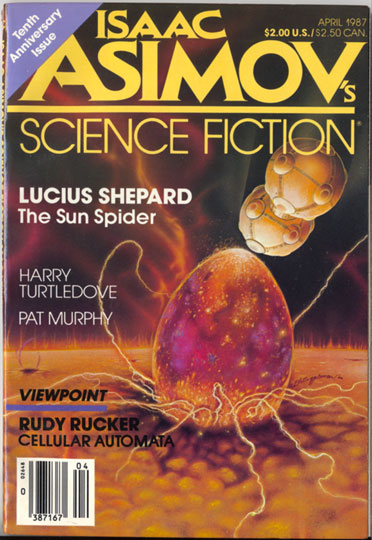 Her attachment to Jake doesn’t stop her from planning her escape, however. Each night when Jake passes out from drinking, Rachel roams the lab, assembling everything she might need to survive in the desert. She fears what the researchers might have planned for her if she doesn’t get free.
Her attachment to Jake doesn’t stop her from planning her escape, however. Each night when Jake passes out from drinking, Rachel roams the lab, assembling everything she might need to survive in the desert. She fears what the researchers might have planned for her if she doesn’t get free.
Rachel becomes so attached to Jake that she decides she’s in love with him. When her chimp body goes into heat, she encourages him to mate with her. But Jake sees only Rachel-the-chimp, and goes back to drinking and looking at pictures of “real” women. Frustrated with sexual longing and aching to be touched, she turns to fellow chimp Johnson, a young male that Rachel has been instructing in ASL when the researchers aren’t around. They mate, physically and emotionally. Rachel knows that it’s finally time to escape, and she brings Johnson with her into the mountains.
During their travels, the true nature of her father’s experiments and the details of his will are revealed to the public. He made certain that Rachel will be cared for and protected, not hunted or experimented on, although the news hasn’t yet reached Rachel and Johnson. Haunted by the memories of life with her father, she’s been making her way through the mountains and back to the ranch house where she lived with him. One assumes that Rachel and Johnson will be able to live there in peace.
How it Changed the Map: The most notable aspect of Murphy’s deeply moving story (I cried. Twice.) is its contrast to other cyberpunk stories being published in the 1980’s. There’s no question that “Rachel in Love” belongs in the cyberpunk genre. A human’s personality and memories have been downloaded into something not human, in this case a chimp rather than a robot. The story doesn’t depict a gritty, urban, rock ‘n roll vision of a cybernetic future like other stories in the genre. Its setting is a barren desert, a metal cage, a quiet lab at night. But “Rachel in Love” one of the finest — and deepest — cyberpunk stories ever written.
As for feminist content, the story reminds us of a sad historical fact — women, and particularly people of color, have been badly used by medical researchers. People point to “Rachel in Love” as an animal rights story, and it certainly is, but it also links the fate of powerless minorities with powerless animals used in research and cautions us about the price paid by the subjects of those experiments.
Regarding its place among feminist fantastic fiction, this Second Wave story also deals with a theme that other feminist writers were tackling at the time — sexual expression and desire. Early feminist fantastic fiction often depicted heterosexual sex as a form of oppression. And in a world without birth control or antibiotics or women’s rights, it was probably often both oppressive and dangerous. “Rachel in Love” portrays the changing ways in which women were able to view their sexuality as they achieved a more equal footing in society. Rachel needs to make choices about her sexuality, not have the choices made for her by a male, in order to pass from puberty to adulthood. By seeking out Johnson and initiating sex with him, she is able to finally find fulfillment, happiness, and maturity on her own terms.
Next Month: We explore Joanna Russ’s classic story of feminism, gender, and time-travel from 1975: The Female Man.

So I read these stories about ten years ago, so let’s see what my 26 year-old-self thought (lord, how pretentious I was…..)
“And I Awoke and Found Me Here on the Cold Hill Side”
by James Tiptree Jr., 1972
Essay by Wendy Pearson
My first Tiptree story! This one took me a minute to get into, and now that I’m thinking of it, it’s the second story in the anthology with a male narrator, though it’s not apparently obvious at the very beginning thanks to the first person POV. But then again, that’s my current perspective getting in the way, because I know Tiptree is actually a woman, and therefore want to assign the writer’s sex to the sex of the narrator. Anyway, the story was a creepy one, and I loved the symbols, the themes, and the parallels. Seeing humanity as a whole reduced to the “other” by the superior alien races was somewhat gratifying, but also terrifying. I noticed this story is also in my Tiptree short story anthology that I ordered, so I’ll be glad to visit once again, as well as put it in context with her other work, which is what the essay of for this story tried to do.
“Wives”
by Lisa Tuttle, 1976
Essay by Cathy Hawkins
Now the parallels to this story are a little bit obvious. Okay, so they’re a lot obvious, but they’re interesting, and they don’t rub the wrong way, even though it’s obvious (I can’t seem to stop using this word) that the story is heavily influenced by the so-called radical feminism of the seventies. What I appreciated about this story was the development of the alien culture, how they reduced themselves to “wives” in order to survive, what their solidarity in protecting their safety, even though it meant killing one of their own and turning their back on freedom and their own culture. It’s a chilling tale, and one that doesn’t need the companion essay to get the point across, though the companion essay was enlightening as well.
“Rachel in Love”
by Pat Murphy, 1987
Essay by Joan Haran
This was the second story that just really stood out to me. I loved the premise of a chimp with a human girl’s personality imprinted on her, and I loved just about everything that unfolded in this tale. It’s open, honest, and unflinching, and that’s something I can appreciate. One can almost read it as a literary story, and while it’s obviously SF–particularly to my tastes–it’s a story I could easily recommend to friends of mine who aren’t “into” SF.
What really surprised me, though, was the essay, which discussed the cyberpunk movement and how said movement seems to exclude women, but yet how this story could be considered cyberpunk. Talk about a head-scratcher, but an eye opener concerning the history of that subgenre, which is one I’m waiting to sit down and really dive into, but not yet.
Whatever the context, it’s a fantastic story that stands on its own.
****
I’m going to have to re-read this anthology/book of essays one day, now that I’m older and maybe wiser (but definitely better-read) to see how my thoughts have changed over the years.
Awww, I love this and I love that you saved all your papers!! Yes, you’re right, “Rachel in Love” IS a literary story. It’s just gorgeous and heartbreaking on every level. (I’m still angry at Dad.)
Great collection and analysis of stories. I think I have read only the first one, which has the distinction of being the only Tiptree story I’ve read. I really want to change that. Lisa Tuttle, though! I’ve read plenty of her other stories, and think she is one of the most underrated horror writers. The third story, “Rachel in Love,” makes me think of Peter Dickinson’s “Eva” which I think was published in the late 80s. http://peterdickinson.com/books/eva/. Now I’m going to have to read “Rachel in Love.”
You should totally get this anthology. It’s awesome.
YES!!! It’s full of gems. The essays really help explain the historical context for some of them, particularly the older stuff.